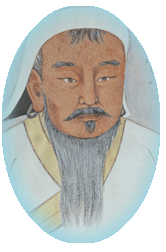
| Mongolia Today | |
| Introduction | |
| The Soyombo & the Mongolian Flag | |
| Map of Mongolia Today | |
| Links to other useful resources | |
| Back to Main | |

| |
|
|
|
|
|
||
| |
 |
|
|
||||
| |
|
|
|||||
| |
|
|
|||||
| |
|
|
|
|
|
||
| |
|||||||
| Located on the Central Asian plateau, Mongolia is landlocked and caught between its two gigantic neighbors, China and Russia. While it appears diminutive, Mongolia is 1/6 the total area of the U.S., or 971,913 sq. miles (1,564,100 square km). If placed inside the U.S., its borders would extend from Washington, D.C. to Denver, CO.* | ||||
| The Mongolian
landscape ranges from the Altai Mountains to the Gobi Desert. However
beautiful the landscape, the inhospitable climactic conditions (-6°F,
-21°C) in winter, Arctic winds, and hot, dry summers (64°F,
or +18°C) make Mongolia a challenging environment to inhabit.*
About 2.4 million people live in Mongolia today, making it one of the most sparsely populated countries in the world (1.5 people per square km, or .9 per square mile). * As 36.1% are under the age of 15, the population is very young. *
|
 |
|||
| Baatar with her son (Ganzorig), his wife and baby on the left and her daughters and grandchild on the right. Hentii Aimag. | ||||
| The Mongolian population is relatively homogenous, made up of groups belonging to the Mongolian and Turkic nationalities. More than 70% of the total population belongs to the major Mongolian ethnic group, the Halh (Khalkha), while the other Mongolian ethnic groups - Buriad, Dorvod, Barga, Uzemchin, Darhad, Oold, Torguud, etc. - comprise another 24%. | ||||
|
The remaining 6% are Turkic peoples: Kazakhs, Tuvinians, Urianhai, and Hoton. * The majority of people practice Tibetan Buddhism, although a significant number is atheist, owing to 6 decades of Communist rule (1924-1990). Shamanism is also making a come-back, especially in Ulaanbaatar. The Turkic Mongols practice Islam, while a small part of the population practices Christianity or other religions.
|
||||
| "...Genghis Khan and his descendants established the largest empire in the world..." |  |
|||
| Today, almost half of the Mongolian population is herders or farmers. The herders still follow the traditional nomadic life style, raising cattle in the countryside and living in felt gers, or yurts, which are round homes with folding wooden walls for quick assembly and disassembly. | ||||
| A quarter of
the population is employed in trade, industry, transportation, and
communication; the rest work in other sectors - service, government,
education, and science.*
Mongolians are highly educated;
the literacy rate is above 83%.*
Mongolia is a country with ancient cultures and traditions, its history dating to the Paleolithic period (500,000 years ago). * In the 13th century, Genghis Khan and his descendants established the largest empire in the world, extending deep into the Euro-Asian continent.
|
 |
|||
| Byambadorj, a shaman practicing in Ulaanbaata | ||||
|
Following several centuries of independence, Mongolia
came under the domination first of Chinese (Manchu) rulers and then
of Soviet Russia. In the 13th century, Genghis Khan and his descendants
established the largest empire in the world, extending deep into
the Euro-Asian continent.
|
||||
|
In 1990, after public demonstrations for democratization of the government, Mongolia officially abandoned socialism and rule by the Communist Party (MPRP), adopting a free market economy and democratic government. Today, Mongolia practices parliamentarian democracy, having successfully made a peaceful transition from communism to democracy. |
 |
|||
| A Tibetan Buddhist (Lamaist) temple, Ulaanbaatar. | ||||